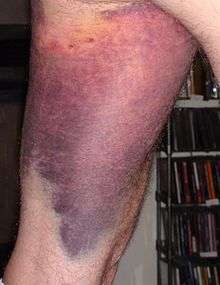Definify.com
Webster 1913 Edition
Livid
Liv′id
(lĭv′ĭd)
, Adj.
[L.
lividus
, from livere
to be of a blush color, to be black and blue: cf. F. livide
.] 1.
Black and blue; grayish blue; of a lead color; discolored, as flesh may be from a contusion.
Cowper.
There followed no carbuncles, no purple or
livid
spots, the mass of the blood not being tainted. Bacon.
Webster 1828 Edition
Livid
LIV'ID
,Adj.
Black and blue; of a lead color; discolored, as flesh by contusion.
Upon my livid lips bestow a kiss.
Definition 2025
livid
livid
See also: lívid
English

A large, livid hematoma (bruise) on the inner left thigh of the subject, five days after he fell from a cliff while snowboarding
Adjective
livid (comparative livider or more livid, superlative lividest or most livid)
- Having a dark, bluish appearance.
- 1733, [Antoine?] Deidier, “Chap. II. The General Affections of the Human Body. [marginal note: Experiments with the Bile of Persons who Died of the Plague at Marseilles in 1721. By Dr. Deidier. n. 370, p. 20. Jan. &c. 1722.]”, in Mr. Reid and John Gray, editors, The Philosophical Transactions (from the year 1720 to the year 1732) Abridged, and Disposed under General Heads, volume VI, part III (Containing the Anatomical and Medical Papers), London: Printed for William Innys and Richard Manby, Printers to the Royal Society, at the West End of St. Paul's, OCLC 642248925, page 166:
- Jean Raynaud, cook, aged about twenty years, of a melancholy temperament, had his whole body covered with a purple livid colour, and a bubo under his left axilla; […] His lungs were covered with little livid ſpots, ſoft and pliant, without any hardneſs in their ſubſtance. The liver was larger and harder than ordinary, and was alſo full of livid purple ſpots; […]
- [1874], John Ruskin, Proserpina: Studies of Wayside Flowers, while the Air was yet Pure among the Alps and in the Scotland and England which my Father Knew; Ariadne Florentina: Six Lectures on Wood and Metal Engraving given before the University of Oxford, in Michaelmas Term, 1872, with Appendix; The Opening of the Crystal Palace: Considered in some of its Relations to the Prospects of Art, New York, N.Y.: John W. Lovell, OCLC 190826485:
- In [J. M. W.] Turner's distinctive work, colour is scarcely acknowledged unless under influences of sunshine. The sunshine is his treasure; his lividest gloom contains it; his greyest twilight regrets it, and remembers.
- 1895, Marie Corelli, The Sorrows of Satan, or, The Strange Experience of one Geoffrey Tempest, Millionaire: A Romance, London: Methuen Publishing, OCLC 500849762, page 395:
- When all the surroundings were thus rendered as brilliant as possible, so that the corpse looked more livid and ghastly by comparison, I seated myself once more, and prepared to read the last message of the dead.
- 1929, M. Barnard Eldershaw, “Chapter VII”, in A House Is Built, section vi:
- The house seemed unfamiliar in the dark stormy light; the red and purple glass of the front door made livid bruises on the linoleum; the green chenille curtain was like a veil of seaweed.
-
- Pale, pallid.
- 1678, J[ohn] S[hirley], A Short Compendium of Chirurgery: Containing its Grounds & Principles. More Particularly Treating of Imposthumes, Wounds, Ulcers, Fractures & Dislocatons. Also a Discourse of the Generation and Birth of Man, very Necessary to be Understood by all Midwives and Child-bearing Women. With the Several Methods of Curing the French Pox: The Cure of Baldness, Inflammation of the Eyes, and Toothach[sic]: And an Account of Blood-letting, Cup-setting, and Blooding with Leeches, London: Printed by W. G. and are to be sold by Charles Blount, at the Black Raven in the Strand, near Worcester-House, OCLC 17215760, page 89:
- Ulcers having had their beginning during a Diſeaſe, or before it, growing livid, pale or dry, plainly indicate the proximity of Death, their livid or pale colour being not only the ſign of Cholerick, or Atrabiliary humours cauſing them, but alſo manifeſting an extinction of the natural heat.
- 1829, “Hymenomycetes, Genera and Species”, in J[ohn] C[laudius] Loudon, editor, An Encyclopædia of Plants; Comprising the Description, Specific Character, Culture, History, Application in the Arts, and every other Desirable Particular Respecting all the Plants Indigenous, Cultivated in, or Introduced to Britain [...], London: Printed for Longman, Rees, Orme, Brown, and Green, Paternoster-Row, OCLC 8593748, page 999:
- 15939 Cap somew[hat] umbon[ate] smooth livid pale, Lamel[læ] annexed flesh-colored, Stipes sold smooth somew[hat] bulbous. [Describing a species of fungus.]
- 2014, Francesco Verso, Livid, Surry Hills, N.S.W.: Xoum Publishing, ISBN 978-1-922134-30-2:
- I'm livid; a deathly pale light floods my face and I emanate a different smell. Charlie doesn't stop to analyse these subtle changes.
-
- (informal) So angry that one turns pale, very angry, furious.
- 1843 December 19, Charles Dickens, A Christmas Carol. In Prose. Being a Ghost Story of Christmas, London: Chapman & Hall, OCLC 1358313:
- Suppose it should not be done enough! Suppose it should break in turning out! Suppose somebody should have got over the wall of the back-yard, and stolen it, while they were merry with the goose—a supposition at which the two young Cratchits became livid! All sorts of horrors were supposed.
- 1956, Tiffany Thayer, Tiffany Thayer's Mona Lisa; I. The Prince of Taranto: A Fiction in Three Volumes, volume I, New York, N.Y.: Dial Press, OCLC 7398449, page 715:
- Livider and livider Serjianni grew as the Princess let him have it. When she stopped, he growled. "Your Highness knows him better than I do," and he stalked off up the stairs.
-
Derived terms
Translations
having a dark, bluish appearance
pallid — see pallid
very angry, furious